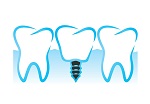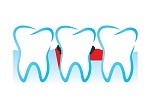






Invisalign® takes a modern approach to straightening teeth, using a custom-made series of aligners created for you and only you. These aligner trays are made of smooth, comfortable and virtually invisible plastic that you wear over your teeth. Wearing the aligners will gradually and gently shift your teeth into place, based on the exact movements your dentist plans out for you. You’ll achieve a great smile with little interference in your daily life. The best part about the whole process is that most people won't even know you're straightening your teeth.







Everyone's bone and jaw structures are unique. Therefore, dentist will study your eating methods, swallowing techniques, profile and general bone structure before placing any braces that is only if they are needed. Orthodontics, known as braces, are just a device used to tidy that interior and exterior crowding of the teeth. It puts your teeth back into place, so that they will not top or push one another around. And as said each structure is a world of its own, and dentist examines that uniqueness and prepare an orthodontics just for you.





You can always replace your badly decaying or missing teeth with natural looking ones. Implants are an easy option, which provides ease and comfort, and restores your bone structure. No difficulties of speech or food processing will be noticed since implants are almost natural, permanent solution. Dental Implants will make you smile again.







When the pulp that is inside the tooth becomes infected, it cannot repair itself. Years ago,extraction was the only option. Today, through endodontics, or root canal therapy, these teeth can be saved.





The leading cause of tooth loss in adults today is periodontal disease, or gum disease. Early diagnosis and treatment for the disease is critical for maintaining healthy teeth and gums. The treatment may include scaling, root planning and periodontal surgery.







Wisdom teeth, or third molars, do not always erupt properly when they decide to make an appearance. It's wise to get an early opinion from dentist on getting wisdom teeth pulled before they become impacted, causing pain, swelling, infection, caries and gum disease.





As a family and cosmetically oriented practice, we focus on helping our patients achieve and maintain optimum oral health. As part of every examination and cleaning, your mouth will be checked for oral cancer, cavities, periodontal and gum disease, jaw joint and bite problems. We perform routine cleanings as well as non-surgical periodontal treatments. Fluoride treatments and sealant can help decrease the chances of developing cavities when combined with proper home care and regular professional cleanings.







We are concerned about your dental emergency and will do what we can to get you out of pain quickly and affordably. If you have had a dental accident that involves bleeding, severe pain or swelling, healthy teeth traumatically broken or knocked out, please call us: Richmond Hill (905) 237-5680, Scarborough (416) 498-8988.





Minor cavities can be restored with either silver or white (tooth-colored) fillings. This type of treatment is a good way of correcting a small problem before it becomes a bigger and more expensive problem.







It refers to a type of dentistry where tooth-colored materials (usually porcelain) are bonded to prepared teeth (usually front teeth) in order to make them straight, white and more beautiful. The term "veneers" is commonly associated with cosmetic dentistry. These are thin pieces of porcelain which are placed on teeth in the smile zone to enhance their appearance.





Dentist supervised bleaching is the safest and most effective method to brighten your smile. Two systems are offered for your convenience: an in-office procedure and a take-home delivery system.







Radiographic or X-ray examinations provide dentist with an important tool that shows the condition of your teeth, their roots, jaw placement, and the overall composition of your facial bones. X-rays can help dentist determine the presence or degree of periodontal disease, abscesses, and many abnormal growths, such as cysts and tumors. X-rays also can show the exact location of impacted and un-erupted teeth, and pinpoint the location of cavities and other signs of disease that may not be possible to detect through a visual examination.





When too much of a tooth is decayed or broken away, it is best restored with a crown. A crown is typically fabricated with porcelain (a tooth-colored material) or gold.







A bridge is a dental appliance that replaces one or more natural missing teeth, thereby "bridging" the space between two teeth. Fixed bridges are cemented into place next to abutment teeth - the surrounding teeth on either side of the space or span. Unlike removable partial dentures, fixed bridges cannot be taken out of the mouth by patient. A fixed bridge is a device that typically consists of three units- a pontic (a false tooth) fused between two crowns that are cemented to abutment teeth.





Autoclave: It is a standard and reliable sterilizing method which kills infectious viruses and bacteria. All instruments which can withstand high heat are autoclaved.
Work surface decontamination: All work surfaces in the operatories are disinfected with a solution formulated to kill bacteria and viruses. This includes the dental chair instrument hangers, lights and light handles, hoses, and counter tops.
Disposable gloves and masks: Masks and gloves are used to prevent transmission of disease between the patient and the doctor/staff.
Single use items: Many of the items used during your visit are one time use and are disposed of after each patient. This includes syringes, saliva ejectors, resining cups, prophy rubber cups, plastic cover sheets, etc.




